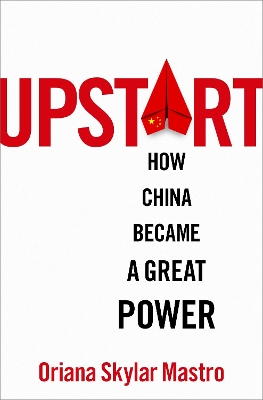Institutionalizing Violence
 -10%
portes grátis
-10%
portes grátis
Institutionalizing Violence
Strategies of Jihad in Egypt
Drevon, Jerome
Oxford University Press Inc
09/2022
264
Dura
Inglês
9780197643693
15 a 20 dias
526
Descrição não disponível.
Table of Contents
Acknowledgements
List of Illustrations
List of Abbreviations
Arabic Glossary
Arabic Transliteration
CHAPTER 1 Introduction
1.1. How Important are Jihadi Groups' Strategic Developments?
1.2. Jihad and its Aftermath in Egypt
1.3. The Concepts of Radicalization and Institutionalization
1.4. The First Argument: Jihadi Groups' Radicalization and Institutionalization
1.5. The Second Argument: Jihadi Groups' Institutionalization and Long-Term Strategic Evolution
1.6. The Scope of the Model and Contribution to Existing Research
1.7. Overview of the Chapters
CHAPTER 2 Institutionalizing Violence
2.1. Jihadi Groups' Relational Radicalization
2.2. Comparative Mechanisms of Radicalization and Beyond
2.3. Jihadi Groups' Institutionalization
2.4. Radicalization and Institutionalization
2.5. Institutionalization and Long-Term Strategic Evolution
CHAPTER 3 Two Trajectories to Jihad
3.1. The Seeds of Violence Before and After Nasser's Free Officers
3.2. Religion and Politics Under Sadat
3.3. Covert Jihad Group Mobilization
3.4. From Mass Movement Proselytization to Jihad
3.5. Towards an Armed Confrontation: Killing Pharaoh
3.6. Conclusion
CHAPTER 4 Strategy Institutionalization
4.1. Cementing the Roots of Salafi Jihadi Opposition to the Regime in Prison
4.2. Early Institutionalization after Sadat's Assassination Trials
4.3. Denouncing Other Islamists and Religious Institutions
4.4. A Contentious Exile to Afghanistan and Pakistan and the Cradle of al-Qaeda
4.5. Ideological Radicalization in Exile?
4.6. A Strategic Deadlock and the Transnationalization of Jihad
4.7. Reinterpreting Salafi Jihadi Ideology
4.8. Conclusion
CHAPTER 5 Confronting the Regime and Fighting the Far Enemy
5.1. Reacting to Repression
5.2. The Militarization of the Conflict
5.3. A Fight for Survival
5.4. Relocating Jihad Abroad
5.5. Conclusion
CHAPTER 6 The Emergence of Non-Violent Political Alternatives
6.1. What Happened to the Other Islamists?
6.2. The Institutionalization of Jihadi Groups' Collective Identities
6.3. Responding to a Short-Lived Democratization
6.4. Conclusion
CHAPTER 7 Conclusion
7.1. The Institutional Trajectories of the Islamic and Jihad Groups
7.2. Armed Violence Beyond Egypt
7.2.1. The Strategic Development of Al-Qaeda and Islamic State
7.2.2. Political Violence and Democracy
7.2.2. The Role of Ideas
7.3. Understanding Jihadi Groups as Groups
Annex: Methodology and Field Research
Bibliography
Acknowledgements
List of Illustrations
List of Abbreviations
Arabic Glossary
Arabic Transliteration
CHAPTER 1 Introduction
1.1. How Important are Jihadi Groups' Strategic Developments?
1.2. Jihad and its Aftermath in Egypt
1.3. The Concepts of Radicalization and Institutionalization
1.4. The First Argument: Jihadi Groups' Radicalization and Institutionalization
1.5. The Second Argument: Jihadi Groups' Institutionalization and Long-Term Strategic Evolution
1.6. The Scope of the Model and Contribution to Existing Research
1.7. Overview of the Chapters
CHAPTER 2 Institutionalizing Violence
2.1. Jihadi Groups' Relational Radicalization
2.2. Comparative Mechanisms of Radicalization and Beyond
2.3. Jihadi Groups' Institutionalization
2.4. Radicalization and Institutionalization
2.5. Institutionalization and Long-Term Strategic Evolution
CHAPTER 3 Two Trajectories to Jihad
3.1. The Seeds of Violence Before and After Nasser's Free Officers
3.2. Religion and Politics Under Sadat
3.3. Covert Jihad Group Mobilization
3.4. From Mass Movement Proselytization to Jihad
3.5. Towards an Armed Confrontation: Killing Pharaoh
3.6. Conclusion
CHAPTER 4 Strategy Institutionalization
4.1. Cementing the Roots of Salafi Jihadi Opposition to the Regime in Prison
4.2. Early Institutionalization after Sadat's Assassination Trials
4.3. Denouncing Other Islamists and Religious Institutions
4.4. A Contentious Exile to Afghanistan and Pakistan and the Cradle of al-Qaeda
4.5. Ideological Radicalization in Exile?
4.6. A Strategic Deadlock and the Transnationalization of Jihad
4.7. Reinterpreting Salafi Jihadi Ideology
4.8. Conclusion
CHAPTER 5 Confronting the Regime and Fighting the Far Enemy
5.1. Reacting to Repression
5.2. The Militarization of the Conflict
5.3. A Fight for Survival
5.4. Relocating Jihad Abroad
5.5. Conclusion
CHAPTER 6 The Emergence of Non-Violent Political Alternatives
6.1. What Happened to the Other Islamists?
6.2. The Institutionalization of Jihadi Groups' Collective Identities
6.3. Responding to a Short-Lived Democratization
6.4. Conclusion
CHAPTER 7 Conclusion
7.1. The Institutional Trajectories of the Islamic and Jihad Groups
7.2. Armed Violence Beyond Egypt
7.2.1. The Strategic Development of Al-Qaeda and Islamic State
7.2.2. Political Violence and Democracy
7.2.2. The Role of Ideas
7.3. Understanding Jihadi Groups as Groups
Annex: Methodology and Field Research
Bibliography
Este título pertence ao(s) assunto(s) indicados(s). Para ver outros títulos clique no assunto desejado.
Table of Contents
Acknowledgements
List of Illustrations
List of Abbreviations
Arabic Glossary
Arabic Transliteration
CHAPTER 1 Introduction
1.1. How Important are Jihadi Groups' Strategic Developments?
1.2. Jihad and its Aftermath in Egypt
1.3. The Concepts of Radicalization and Institutionalization
1.4. The First Argument: Jihadi Groups' Radicalization and Institutionalization
1.5. The Second Argument: Jihadi Groups' Institutionalization and Long-Term Strategic Evolution
1.6. The Scope of the Model and Contribution to Existing Research
1.7. Overview of the Chapters
CHAPTER 2 Institutionalizing Violence
2.1. Jihadi Groups' Relational Radicalization
2.2. Comparative Mechanisms of Radicalization and Beyond
2.3. Jihadi Groups' Institutionalization
2.4. Radicalization and Institutionalization
2.5. Institutionalization and Long-Term Strategic Evolution
CHAPTER 3 Two Trajectories to Jihad
3.1. The Seeds of Violence Before and After Nasser's Free Officers
3.2. Religion and Politics Under Sadat
3.3. Covert Jihad Group Mobilization
3.4. From Mass Movement Proselytization to Jihad
3.5. Towards an Armed Confrontation: Killing Pharaoh
3.6. Conclusion
CHAPTER 4 Strategy Institutionalization
4.1. Cementing the Roots of Salafi Jihadi Opposition to the Regime in Prison
4.2. Early Institutionalization after Sadat's Assassination Trials
4.3. Denouncing Other Islamists and Religious Institutions
4.4. A Contentious Exile to Afghanistan and Pakistan and the Cradle of al-Qaeda
4.5. Ideological Radicalization in Exile?
4.6. A Strategic Deadlock and the Transnationalization of Jihad
4.7. Reinterpreting Salafi Jihadi Ideology
4.8. Conclusion
CHAPTER 5 Confronting the Regime and Fighting the Far Enemy
5.1. Reacting to Repression
5.2. The Militarization of the Conflict
5.3. A Fight for Survival
5.4. Relocating Jihad Abroad
5.5. Conclusion
CHAPTER 6 The Emergence of Non-Violent Political Alternatives
6.1. What Happened to the Other Islamists?
6.2. The Institutionalization of Jihadi Groups' Collective Identities
6.3. Responding to a Short-Lived Democratization
6.4. Conclusion
CHAPTER 7 Conclusion
7.1. The Institutional Trajectories of the Islamic and Jihad Groups
7.2. Armed Violence Beyond Egypt
7.2.1. The Strategic Development of Al-Qaeda and Islamic State
7.2.2. Political Violence and Democracy
7.2.2. The Role of Ideas
7.3. Understanding Jihadi Groups as Groups
Annex: Methodology and Field Research
Bibliography
Acknowledgements
List of Illustrations
List of Abbreviations
Arabic Glossary
Arabic Transliteration
CHAPTER 1 Introduction
1.1. How Important are Jihadi Groups' Strategic Developments?
1.2. Jihad and its Aftermath in Egypt
1.3. The Concepts of Radicalization and Institutionalization
1.4. The First Argument: Jihadi Groups' Radicalization and Institutionalization
1.5. The Second Argument: Jihadi Groups' Institutionalization and Long-Term Strategic Evolution
1.6. The Scope of the Model and Contribution to Existing Research
1.7. Overview of the Chapters
CHAPTER 2 Institutionalizing Violence
2.1. Jihadi Groups' Relational Radicalization
2.2. Comparative Mechanisms of Radicalization and Beyond
2.3. Jihadi Groups' Institutionalization
2.4. Radicalization and Institutionalization
2.5. Institutionalization and Long-Term Strategic Evolution
CHAPTER 3 Two Trajectories to Jihad
3.1. The Seeds of Violence Before and After Nasser's Free Officers
3.2. Religion and Politics Under Sadat
3.3. Covert Jihad Group Mobilization
3.4. From Mass Movement Proselytization to Jihad
3.5. Towards an Armed Confrontation: Killing Pharaoh
3.6. Conclusion
CHAPTER 4 Strategy Institutionalization
4.1. Cementing the Roots of Salafi Jihadi Opposition to the Regime in Prison
4.2. Early Institutionalization after Sadat's Assassination Trials
4.3. Denouncing Other Islamists and Religious Institutions
4.4. A Contentious Exile to Afghanistan and Pakistan and the Cradle of al-Qaeda
4.5. Ideological Radicalization in Exile?
4.6. A Strategic Deadlock and the Transnationalization of Jihad
4.7. Reinterpreting Salafi Jihadi Ideology
4.8. Conclusion
CHAPTER 5 Confronting the Regime and Fighting the Far Enemy
5.1. Reacting to Repression
5.2. The Militarization of the Conflict
5.3. A Fight for Survival
5.4. Relocating Jihad Abroad
5.5. Conclusion
CHAPTER 6 The Emergence of Non-Violent Political Alternatives
6.1. What Happened to the Other Islamists?
6.2. The Institutionalization of Jihadi Groups' Collective Identities
6.3. Responding to a Short-Lived Democratization
6.4. Conclusion
CHAPTER 7 Conclusion
7.1. The Institutional Trajectories of the Islamic and Jihad Groups
7.2. Armed Violence Beyond Egypt
7.2.1. The Strategic Development of Al-Qaeda and Islamic State
7.2.2. Political Violence and Democracy
7.2.2. The Role of Ideas
7.3. Understanding Jihadi Groups as Groups
Annex: Methodology and Field Research
Bibliography
Este título pertence ao(s) assunto(s) indicados(s). Para ver outros títulos clique no assunto desejado.







